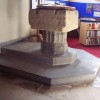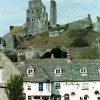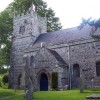People out walking along a path near the Purbeck coast for a time during the late 1940’s may have been surprised by the regular appearance of a woman in a duffel coat and boots, riding a pony with a spaniel keeping pace beside them. The woman was Elizabeth Muntz, then almost 40, and her rides along the coast path in those years were not simply for pleasure, but to undertake more work on an ambitious piece of craftsmanship: one of many which she would become famous throughout her adopted county and far beyond.
Certainly to many, Elizabeth Muntz would have been regarded as a Dorsetian. For most of her life her home and her base of operations were in Dorset. Several of the splendid sculptures of her life were made for, and reside in Dorset. Muntz lived with her sister, and both women died and were buried in Dorset. Yet this renowned sculptor was born and raised in Toronto, Canada – over three thousand miles from the county in which she made her home so early in her life.
She studied at the Acadamie Grand Chaumier and Boudelle in Paris, as well as in London under Frank Dobson RA. Her work was first shown publicly in 1928, a piece in yellow Mansfield stone, though Muntz also worked in bronze and some other metals. One of her bronze sculptures – a double figurine of a woman and a baby – prompted the famous sculptor Jacob Epstein to remark that it was “decidedly the work of a woman”. But she was an all-rounder of great skill, a polymath of the arts. Small wonder that many architects found in Elizabeth’s work the inspiration for works of their own.
With her sister Isabelle Hope Muntz, a noted historical novelist, Elizabeth settled in East Chaldon (Herring), acquiring two adjoining Elizabethan cottages she knocked into one to accommodate her studio using, it is said, timbers from a Spanish Galleon wrecked during the Armada. She named this cosy retreat Apple Tree Cottage, because at the time of the purchase an apple tree was the only thing to be seen growing in the garden. But possibly her choice of this home was a strategic one, for it was conveniently close to the Portland and Purbeck quarries from which she would obtain the stone for her remarkable sculptures.
Though she never married or had any of her own, Elizabeth Muntz had a lasting affection for children, who were so often the inspiration for her drawings, paintings and sculptures. Once, a seven-year-old local boy sat for her as she produced a series of sketches of him. For a time during her long years at Apple Tree Cottage her studio doubled as a successful summer school for enthusiastic young people to come and learn painting, pottery and sculpture. Flowers, fruits and cheeses also particularly inspired her. Elizabeth even co-authored a story for children called ‘The Dolphin Bottle,’ which she also illustrated.
Other subjects for her sculptures were decidedly more unconventional, yet they nevertheless demonstrated her versatility. One of these was a replica of Margaret Alice, a cutter that used to be seen sailing in Lulworth Cove and Ringstead Bay. She expended four years in producing a replica of a Cotswold Manor called ‘Child Court,’ was then presented to the Heritage Craft Schools and Hospitals for crippled children in Chaley, Sussex.
1936 also saw Muntz holding winter instructional classes on Sculpting at a school in London. But it was around 1949 that she undertook one of her most demanding commissions. Llewylin Powys, the youngest of three literary Dorset brothers, desired to have a memorial in stone set up to him. He invited Elizabeth to his home to produce an extensive series of drawings which would be used as a blueprint for a sculpture carved from a single one-ton block of Portland limestone. Before his death in 1939, Powys had chosen the location for his memorial: a cliff-top vantage point near White Nothe in Purbeck.
Since the Powys memorial had to be sculpted in situ, Elizabeth Muntz had to journey to the site from Chaldon each day to see the work through to completion. Taking her food and drink for the day, and with Rumple, her beloved spaniel alongside, the sculptor rode the three-and-a-half kilometres on Merrylegs her pony for a four-hour shift of hammering and chiselling at White Nothe.
The Powys commission, if not the most portable of Elizabeth’s pieces, is probably the most southerly located. But she undertook several other noted commissions for works in Dorset. These included mural panels in carved stone for Broadwey School near Weymouth, Griffins for the entrance gates to Lulworth Manor and lead candlesticks for Eric Kennington’s effigy of Lawrence of Arabia, which resides in St. Martin’s Church in Wareham. She also produced the Dodington memorial in Purbeck stone for the churchyard in Chaldon Herring.
But probably the most unusual sculpture Muntz ever produced was in remembrance of the only cat ever to be awarded the animals VC. Simon was on-board mascot with the Royal Naval sloop ‘Amethyst’. In 1949 the ship was deployed on the Yangste River when the first bombs dropped by the Chinese Communists struck the vessel. In the attack Simon was wounded, his courage later being recognised through the special honour bestowed upon him. The Muntz memorial to Simon’s fortitude took the form of a plaque for the PDSA centre in Plymouth.
In 1949, close to the time that the ‘Amethyst’ was being bombed, an exhibition of Elizabeth’s work was held in London’s West End. In the post-war phase of her creative life she produced, apart from the Simon memorial, a plaque commemorating the late Sir Oliver Lodge’s father for a village in northern England, and a stone effigy of King Harold which now stands in Waltham Abbey. Other works went on display at King’s College, Cambridge and Manchester and Bristol Art Galleries. There was a major exhibition of Muntz works in Dorchester during the summer of 1971.
In later years also, her sculptures won her peculiar honours and worldwide recognition. She was nominated as the first woman freeman of The Ancient Order of Purbeck Marblers & Stone Cutters and was a founder member (and first woman member) of the Guild of memorial Craftsmen, a body formed to maintain and further the standard of memorial sculpting.
At the end of her productive life Elizabeth Muntz died in East Chaldon on 30th of March 1977 in her 82nd year. Possession of her enormous collection of sketches, drawings, paintings, notes, photographs, manuscripts and family memorabilia went to her sister, Isabelle Hope, who lived on at the cottage. When Hope herself died in 1981 the Muntz collection was entrusted to Catherine Morton, a friend who had by then moved in with her. In February 1988 Catherine bequeathed the entire collection to the County Museum in Dorchester. In her will Elizabeth had left £65,116.
Elizabeth was buried in the churchyard of St. Nicholas, East Chaldon, where today the graves of her sister and a life-long colleague-companion, Andre Bonnamy, lie nearby. As already mentioned this churchyard is the home of Muntz’s Dodington memorial, though some may consider it could just as well double as a memorial to Elizabeth herself. It is of course not the sole monument to represent Dorset’s legacy of the works of her hand.



